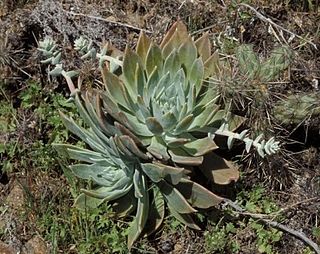
Eriogonum is a genus of flowering plants in the family Polygonaceae. The genus is found in North America and is known as wild buckwheat. This is a highly species-rich genus, and indications are that active speciation is continuing. It includes some common wildflowers such as the California buckwheat.

Eriogonum fasciculatum is a species of wild buckwheat known by the common names California buckwheat and flat-topped buckwheat. Characterized by small, white and pink flower clusters that give off a cottony effect, this species grows variably from a patchy mat to a wide shrub, with the flowers turning a rusty color after blooming. This plant is of great benefit across its various habitats, providing an important food resource for a diversity of insect and mammal species. It also provides numerous ecosystem services for humans, including erosion control, post-fire mitigation, increases in crop yields when planted in hedgerows, and high habitat restoration value.

Ceanothus arboreus is a species of perennial shrub to small tree in the family Rhamnaceae, commonly known as the feltleaf ceanothus, island ceanothus, and island mountain lilac. It is the largest member of the California lilacs, and is characterized with glossy, dark green foliage that is adorned by pale blue to white flowers in bloom. It is endemic to the Channel Islands of California and Guadalupe Island in Mexico, only being re-discovered on Guadalupe Island after the elimination of feral goats.

Lupinus bicolor is a species of lupine known as the miniature lupine, Lindley's annual lupine, pigmy-leaved lupine, or bicolor lupine.

Cirsium occidentale, with the common name cobweb thistle or cobwebby thistle, is a North American species of thistle in the family Asteraceae.

Dudleya traskiae is a rare succulent plant known by the common name Santa Barbara Island liveforever. This Dudleya is endemic to Santa Barbara Island, one of the Channel Islands of California, where it grows on rocky bluffs. The plant has a basal rosette of flat, spade-shaped fleshy leaves up to 15 centimeters long, which are pale green to yellowish. It erects tall stems bearing dense, rounded inflorescences of many bright yellow flowers.

Eriogonum alpinum is a species of wild buckwheat known by the common name Trinity buckwheat.

Eriogonum arborescens is a species of wild buckwheat known by the common name Santa Cruz Island buckwheat.

Eriogonum cinereum is a species of wild buckwheat known by the common names coastal buckwheat and ashyleaf buckwheat.

Eriogonum ovalifolium is a species of wild buckwheat known by the common name cushion buckwheat. It is native to western North America from California to Alberta, where it is a member of many plant communities in varied habitats, including the sagebrush steppe and alpine regions.

Eriogonum wrightii is a species of wild buckwheat known by the common names bastardsage and Wright's buckwheat. It is native to the Southwestern United States, California, and northwest Mexico, where it grows in many plant communities, such as chaparral, in rocky habitats from mountains to deserts.

Eriogonum grande is a species of wild buckwheat known by the common name redflower buckwheat. It is native to northwestern Baja California, as well as the Channel Islands of California. It is a mat-forming perennial herb producing tall, stout inflorescences of white, pink, or red flowers. Leaves are located mainly at the base of the plant and are wavy along the edges and up to 10 centimeters long.

Eriogonum ampullaceum is a species of wild buckwheat known by the common name Mono buckwheat.

Eriogonum sphaerocephalum is a species of wild buckwheat known by the common names rock buckwheat and round-headed desert buckwheat. It is native to the western United States.

Malacothamnus fasciculatus, with the common name chaparral mallow, is a species of flowering plant in the mallow family. It is found in far western North America.

Platanthera cooperi is an uncommon species of orchid known by the common names Cooper's rein orchid and chaparral rein orchid.

Eriogonum callistum is a rare species of wild buckwheat, known by the common name Tehachapi buckwheat.
The wildlife of the Channel Islands of California is wide and diverse, including many endemic species. While the land wildlife is slightly limited, there being only one large, naturally predatory, and native mammal, the small island fox, marine life can include anything from kelp forests to great white sharks.

Eriogonum elongatum, commonly known as longstem buckwheat or wand buckwheat, is a species of wild buckwheat native to coastal southern and Baja California.


















